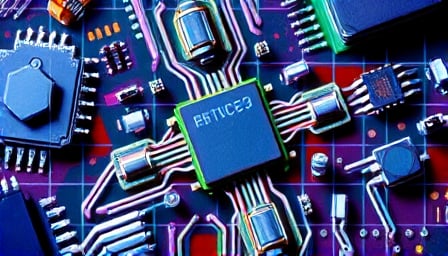Corporate News Report – Intel Corp Secures Potential Apple Investment Amid Strategic Turnaround
Intel Corp’s pursuit of a financial partnership with Apple Inc. is positioned as a pivotal element in the chipmaker’s broader strategy to restore profitability after a series of production setbacks and market share erosion. The discussion follows Intel’s recent $5 billion commitment from Nvidia Corp., underscoring a broader industry trend of cross‑sector alliances aimed at bolstering semiconductor supply chains and sharing capital burdens.
Key Developments
- Intel–Apple talks are reportedly centered on both potential equity investment and the possibility of a dedicated chip‑manufacturing collaboration.
- Market response: Intel’s shares rose 7 % following the announcement, reflecting investor confidence in the partnership’s financial and operational implications.
- Strategic significance: An Apple investment would validate Intel’s turnaround initiatives, provide much-needed liquidity, and potentially open pathways to joint development of next‑generation process nodes.
Semiconductor Technology Landscape
Node Progression and Yield Optimization
Modern semiconductor fabrication has moved from the 7 nm era into sub‑7 nm territories, where lithographic complexity, defect density, and process control become increasingly critical. Yield optimization has become a cornerstone of cost management:
- Advanced lithography: Extreme ultraviolet (EUV) lithography at 7 nm and 5 nm nodes demands precise alignment and defect mitigation. Intel’s recent 7 nm production ramp-up, however, has faced yield bottlenecks due to EUV throughput limitations and mask defectivity.
- Process control: Statistical process control (SPC) tools now integrate machine learning to predict yield variations. Foundries are deploying real‑time data analytics to adjust process parameters on the fly, mitigating defects before they propagate to yield‑critical steps.
- Defect engineering: Surface passivation, anti‑sticking coatings, and advanced defect‑mapping are critical in sub‑10 nm nodes, where a single defect can render an entire die unusable.
Technical Challenges of Advanced Chip Production
- Patterning Density: As transistor gate lengths shrink below 5 nm, conventional optical proximity correction (OPC) becomes insufficient. Sub‑resolution assist features (SRAFs) and double‑patterning techniques are now mandatory.
- Interconnect Reliability: The use of low‑k dielectrics and copper interconnects at reduced dimensions introduces electromigration and dielectric breakdown concerns. New materials such as tantalum nitride (TaN) or advanced copper alloys are being explored to mitigate these effects.
- Thermal Management: Higher transistor densities increase power density, necessitating improved thermal interface materials (TIMs) and 3D‑IC integration strategies to dissipate heat without compromising yield.
Capital Equipment Cycles and Foundry Capacity
Capital expenditure cycles for semiconductor fabrication equipment have lengthened to roughly 5–7 years, driven by the high cost of EUV lithography and advanced etch tools. Foundry operators face:
- Capacity Utilization: With multiple fabs operating at varying maturity levels, capacity allocation is often a balancing act. Intel’s own 10 nm and 7 nm fabs have historically operated at low utilization, partly due to design bottlenecks and supply chain disruptions.
- Tool Depreciation: EUV machines, such as the ASML 5 nm system, carry depreciation schedules that influence financing decisions. An Apple investment could provide Intel with the liquidity required to acquire or lease new EUV tooling, thereby accelerating node transitions.
- Supply Chain Resilience: The global chip shortage exposed vulnerabilities in raw material supply (e.g., high‑purity silicon wafers) and specialized equipment components. A partnership with Apple—who has a vast ecosystem of silicon design and manufacturing—could lead to shared procurement strategies and risk mitigation.
Interplay Between Design Complexity and Manufacturing Capabilities
Modern chip design incorporates heterogeneous integration, with CPU, GPU, and AI accelerators co‑located on a single die. The design complexity grows exponentially:
- Design for Manufacturability (DFM): Engineers must embed manufacturing constraints into the design process early. Techniques such as floorplan optimization, mask rule checking, and lithography‑aware placement reduce the risk of late‑stage yield losses.
- EDA Tool Evolution: Electronic Design Automation (EDA) tools now incorporate AI‑driven optimization to predict lithographic challenges before physical design. This pre‑emptive approach is essential for sub‑5 nm nodes.
- Manufacturing Flexibility: Foundries are increasingly adopting “foundry‑agnostic” processes, enabling design teams to port silicon between fabs. This flexibility reduces dependency on a single vendor and can help manage capacity constraints.
Enabling Broader Technological Advances
Semiconductor innovations are the backbone of many emerging technologies:
- Artificial Intelligence (AI): High‑performance processors, including GPUs and specialized tensor cores, rely on advanced nodes for speed and energy efficiency.
- 5G/6G Connectivity: RF transceivers and massive MIMO arrays demand high‑density interconnects and low‑loss silicon substrates, which are only achievable with sub‑10 nm processes.
- Automotive Electronics: Advanced driver‑assist systems (ADAS) and autonomous vehicles require chips with high reliability and radiation tolerance—attributes that can only be met with mature, high‑yield fabrication processes.
Conclusion
Intel’s pursuit of an Apple investment reflects a broader industry recognition that financial stability, coupled with strategic manufacturing partnerships, is essential for sustaining innovation in an era of escalating complexity and capital intensity. Should the talks materialize into a formal collaboration, it would signal a significant shift in the competitive dynamics of the semiconductor sector, reinforcing the importance of cross‑industry alliances for achieving node progression, optimizing yields, and meeting the rising demands of next‑generation technologies.
